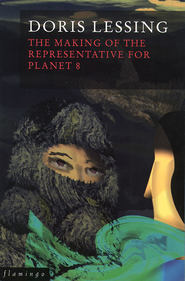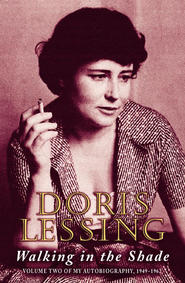По всем вопросам обращайтесь на: info@litportal.ru
(©) 2003-2024.
✖
Going Home
Настройки чтения
Размер шрифта
Высота строк
Поля
The darkness of the earth at night is never complete in Africa, because even the darkest night sky has a glow of light behind it. And so these cities dissolve after sundown, as if points of strong, firm light were strewn wide over a luminous, dark sea.
To drive from the airport to the house I was staying in on the outskirts of the town took seven minutes. I knew that my sense of space, adjusted to sprawling London, was going to take a shock; but I was more confused than I had thought possible. If you live in a small town, you live in all of it, every street, house, garden is palpable all the time, part of your experience. But a big city is a centre and a series of isolated lit points on the darkness of your ignorance. That is why a big city is so restful to live in; it does not press in on you, demanding to be recognized. You can choose what you know.
But it was night; and the town at night was always to me a different place than the candid day-time town. Now the car swept up along avenues of subdued light, for the moon was full and hard, the stars vivid; the trees rippled off light; and the buildings were luminous, their walls thin shells over an inner glow, and the roof plates of shining substance.
The garden of the house was full of roses, pale in the moonlight, and black shadow lay under the bougainvillaea bush.
I stepped from the garden into the creeper-hung verandah and at once into the living-room. It was strange to be in a house again that was pressed close to the earth, with only a thin roof between me and the sky. In London buildings are so heavy and tall and ponderous they are a climate of their own; pavements, streets, walls – even parks and gardens – are an urban shell.
But in Africa the wildness of the country is still much stronger than the towns.
But even so, this house was wrong; it was not this that I had come home to find. For me all houses will always be wrong; all bungalows, cottages, mansions and villas will be uncomfortable and incongruous and confining. I only like blocks of flats, the most direct expression of crammed town-living. I did not understand why this should be so for a long time, until I took to dreaming nightly of the house I was brought up in; and then at last I submitted myself to the knowledge that I am the victim of a private mania that I must humour. I worked out recently that I have lived in over sixty different houses, flats and rented rooms during the last twenty years and not in one of them have I felt at home. In order to find a place I live in tolerable, I have not to see it. Or rather, I work on it until it takes on the colouring suggested by its shape, and then forget it. If, in an unguarded moment, I actually see it, all of it, what it is, then a terrible feeling of insecurity and improbability comes over me. The fact is, I don’t live anywhere; I never have since I left that first house on the kopje. I suspect more people are in this predicament than they know.
But that first house crumbled long ago, returned to the soil, was swallowed by the bush; and so I was glad after we had had dinner to go out again in the car, ostensibly to look for someone whose address we did not know, but hoped we might find by chance – in fact to get out of the town into the bush.
In five minutes we were there.
And now for the first time I was really home. The night was magnificent; the Southern Cross on a slant overhead; the moon a clear, small pewter; the stars all recognizable and close. The long grass stood all around, tall and giving off its dry, sweetish smell, and full of talking crickets. The flattened trees of the highveld were low above the grass, low and a dull silver-green.
It was the small intimate talking of the crickets which received me and made me part of that nightscape.
Before I left home seven years ago I used to walk endlessly at night along the streets, tormented because there was a barrier between me and the steady, solemn magnificence of those skies whose brilliance beat the thin little town into the soil. I saw them, but I was alien to them. This barrier is the urgent necessity of doing the next thing, of getting on with the business of living; whatever it is that drives us on. But on that first night there was no barrier, nothing; and I was effortlessly and at once in immediate intimacy with the soil and its creatures.
It was only so the first night; for at once habit took over and erected its barriers; and if I had had to fly back to England the next day, I would have been given what I had gone home for.
For to stand there with the soft dust of the track under my shoes, the crickets talking in my ear, the moon cold over the bush, meant I was able to return to that other house.
There are two sorts of habitation in Africa. One is of brick, cement, plaster, tile and tin – the substance of the country processed and shaped; the other sort is made direct of the stuff of soil and grass and tree. This second kind is what most of the natives of the country live in; and what I, as a child, lived in. The house was not a hut, but a long, cigar-shaped dwelling sliced several times across with walls to make rooms.
To make such a house you choose a flat place, clear it of long grass and trees, and dig a trench two feet deep in the shape you want the house to be. You cut trees from the bush and lop them to a size and insert them side by side in the trench, as close as they will go. From the trunks of living trees in the bush, fibre is torn; for under the thick rough bark of a certain variety of tree is a thick layer of smooth flesh. It is coloured yellow and pink; and when it is still alive, newly torn from the tree, it is wet and slippery to the touch. It dries quickly; so it is necessary to have several labourers stripping the fibre, with others ready immediately to use it for tying the trees of the walls into place. At this stage the house will look like a small space enclosed by a palisade – tall, uneven logs of wood, greyish-brown in colour, laced tightly with yellow and rose-coloured strips. The palisade will have spaces in it for doors and windows.
On this frame is set the skeleton of the roof. More trees have been cut, slimmer ones, and laid slantwise from the tops of the wall-poles to a ridge in the centre. They are tied with strips of the fibre to this centre pole, which is an immensely long gum tree or thorn tree made smooth and slim, lying parallel to the ground.
Now the house will look like an immense birdcage, set in the middle of the bush. For the trees have not been cut back around it yet; and the grass is still standing high all around, long swatches of grass, a browny-gold in colour. One cannot build this sort of a house save when the grass is dry, at the season for thatching.
Standing inside the cage of rough poles, the sun comes through in heavy bars of yellow. Strips of fading fibre lie everywhere in tangles; chips of wood send off a warm, spicy smell.
Now it is time to make the walls.
From an ant-heap nearby earth is cut in spadefuls and laid in a heap. Ant-heap earth is best, because it has already been blended by the jaws of a myriad workers.
It is not always easy to find the right ant-heap, even in ant-heap country; for even ants cannot make suitable wall-earth where the ingredients are not right at the start. And, having found a properly composed heap, there may be snags. For instance, when we were building our house, the ant-heap we were working had three skeletons laid side by side, in such a way that showed these were the bones of chiefs of a tribe. Earthen cooking-pots buried beside the skeletons still showed traces of white meal mingled with the earth.
Our labourers would not go near this ant-heap again, for they feared the spirits of their ancestors. So we had to choose another. But meanwhile, some of the earth had already been pounded into mud for the walls; and so the walls of our house had in them the flesh and the blood of the people of the country.
To make mud for walls, a great heap of ant-worked earth is built up and wetted. Then the feet of the builders squelch it into the right consistency. Also, in this case, the feet of my brother and myself, who were small children.
To lay the mud on the poles it is carried in petrol tins from the men who are softening it to the men who are plastering; great handfuls are taken up quickly from the tins, before it can dry out, and slapped on to the poles. Sometimes there are gaps between the poles too wide to hold the mud; and then handfuls of grass are caught up and inserted and worked in with the mud. The smell of this mud is fresh and sweet, if the water used is good, clean water.
Soon all the walls are covered with a thick, dark mud-skin; and this is quickly smoothed over with trowels or flat bits of tin. Now the house is a house and not a frame of tree-poles; for the walls cannot be seen through.
Next, the long, pale grass is cut from those parts of the farm where it grows best and tallest, and is laid in piles ready for the thatchers. It is laid swathe over swathe beginning from ridgepole and working downwards, and each swathe is tied into place with the bush-fibre. The grass is laid thick, 18 inches deep; and finally the loose, long tips that draggle almost to the ground are cut off straight and clean with long, sharpened bits of metal.
And now the roof of the house is a gleaming golden colour, laced with rose-pink and yellow; and so it stays until the rains of the first wet season dim the colours.
Meanwhile, the doors have been hung and the windows fitted; and this is not easy when the poles of the walls are likely to be uneven. Nor are those doors and windows ever likely truly to fit; for the wood of lintels and frames swells and contracts with the wetness and the dryness of the time of the year.
The floor is done last. More ant-heap earth is piled, and on it fresh cowdung; and it is wetted with the fresh blood of an ox and with water, and is stamped free of lumps. This mixture is laid all over the earth inside the house and smoothed down. It has a good, warm, sweet smell, even when it dries, which takes about a week.
Now the house is finished and can be lived in. The mud-skin of the walls has dried a pleasant light-grey, or a yellowish-grey. Or it can be colour-washed. The mud of the floor is dark and smooth and glossy. It can be left bare, or protected with linoleum, for after a time this kind of floor tends to scuff into holes and turns dusty, so linoleum is useful, though not as pleasant to look at as the bare, hard, shining earth-floor.
A pole-and-dagga house is built to stand for two, three, four years at most; but the circumstances and character of our family kept ours standing for nearly two decades. It did very well, for it had been built with affection. But under the storms and the beating rains of the wet seasons, the grass of the roof flattened like old flesh into the hollows and bumps of the poles under it; and sometimes the mud-skin fell off in patches and had to be replaced; and sometimes parts of the roof received a new layer of grass. A house like this is a living thing, responsive to every mood of the weather; and during the time I was growing up it had already begun to sink back into the forms of the bush. I remember it as a rather old, shaggy animal standing still among the trees, lifting its head to look out over the vleis and valleys to the mountains.
I wrote a poem once about a group of suburban town houses; which I could not have written had I not been brought up in such a house as I have described:
THE HOUSE AT NIGHT
That house grew there, self-compact;
And with what long hopeless love
I walked about, about –
To make the creature out.
First with fingers: grainy brick
That took its texture from the earth;
The roof, membranous sheath
On rafters stretched beneath.
Yet, though I held the thing as close
As child’s toy gathered in my hand –
Could shatter it or not;
No nearer truth I got.
Eluded by so frail a thing?
But if touch fails then sight succeeds.
But windows shadowed in
My face that peered within.











